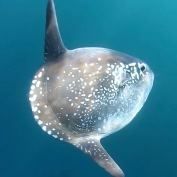New bizarre giant sunfish species 'Hoodwinker' is the first to be discovered in 130 years
The new species has been dubbed 'Hoodwinker' as it eluded discovery for almost 3 centuries.

A new species of sunfish has been discovered by researchers for the first time in 130 years. The giant has been named the "Hoodwinker Sunfish" (Mola tecta), and was found in the cold ocean waters of New Zealand, South Africa, southern Chile and the south-east coast of Australia.
According to researchers, the previously unnamed species has eluded discovery for almost three centuries. The discovery was made by an international team of researchers led by Marianne Nyegaard, a PhD student at Murdoch University.

The new species was discovered while researching the population genetics of ocean sunfish. According to Nyegaard, although Japanese researchers had first found genetic evidence of the bizarre sunfish species in Australian waters 10 years ago, it still eluded discovery because the scientific community didn't know what the fish looked like.
"The new species managed to evade discovery for nearly three centuries by 'hiding' in a messy history of sunfish taxonomy, partially because they are so difficult to preserve and study, even for natural history museums," Nyegaard said.
"That is why we named it Mola tecta (the Hoodwinker Sunfish), derived from the Latin tectus, meaning disguised or hidden. We retraced the steps of early naturalists and taxonomists to understand how such a large fish could have evaded discovery all this time. Overall we felt science had been repeatedly tricked by this cheeky species, which is why we named it the Hoodwinker."
Nyegaard collected data from 27 specimens of the new species over a three-year period, sometimes travelling thousands of miles to the most remote beaches. "Finding these fish and storing specimens for studies is a logistical nightmare due to their elusive nature and enormous size, so sunfish research is difficult at the best of times," she said. "Early on, when I was asked if I would be bringing my own crane to receive a specimen, I knew I was in for a challenging – but awesome – adventure."
Unlike the two other sunfish species, the Hoodwinker Sunfish has a slender and smooth body, despite its larger size. The new species also has no protruding snout or any notable bumps and lumps. Nyegaard's research on the new sunfish species has been published in the Zoological Journal of the Linnean Society.
Nyegaard and her team also painstakingly poured over texts dating as far back as the 16<sup>th century to verify that the discovery made was that of an entirely new species. However, now that the Hoodwinker Sunfish's tricks have been revealed, the researchers are looking to focus on the species' feeding habits, making use of satellite tagging.
"It's quite humbling to know that the ocean still holds so much mystery," Nyegaard told ScienceAlert. "We tend to think that we know everything, but we still have so many mysteries to unravel."
© Copyright IBTimes 2025. All rights reserved.






















